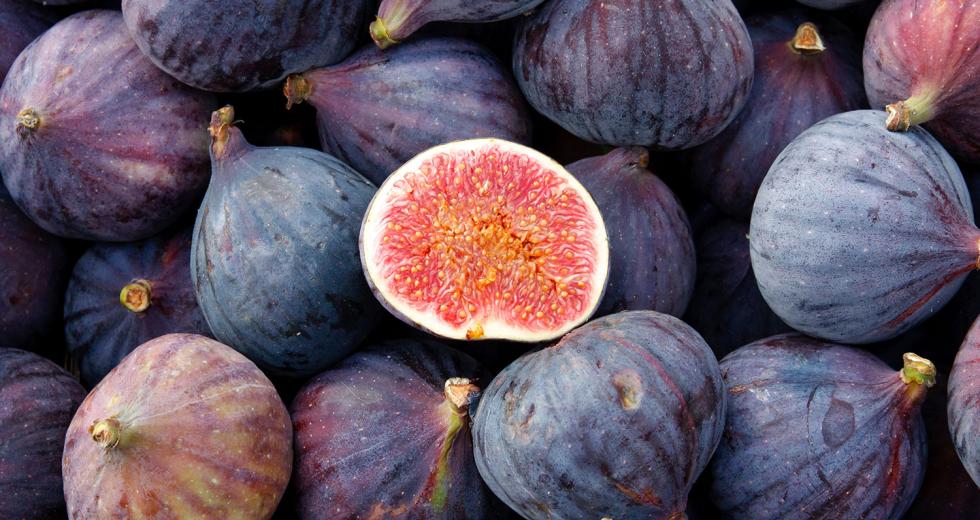Kevin Herman sees his fig trees as his future. They require very little water and, even amid long-term forecasts of limited rain and increasing temperatures, the trees are likely to produce a comfortable living for the Madera County farmer.
But the landscape around Herman has changed over the past 20 years. While fig trees still sprawl for miles across the sweltering flatlands near Fresno, the orchards in the area have been shrinking for decades. In the 1990s, there were more than 20,000 acres of figs here — mostly of the black mission and Calimyrna varieties. Ten years ago, there were 12,000 acres. Now, just 7,000 acres remain, and the problem isn’t waning demand.
“People are still crazy about figs,” Herman says. The fruits, with their teardrop shape and jam-like flesh, have an uncanny power to inspire. Figs have been loved for ages in the Old World, where the trees are a familiar feature of the landscape. They grow from castle turrets, old bridges and virtually every garden along the European Riviera. Spaniards introduced figs to California in the 1700s, and eventually a commercial industry centralized in the San Joaquin Valley. In recent years especially, fresh figs have become superstars of the seasonal produce department. Home gardeners sometimes go crazy over figs, too, and there are a handful of eccentrics who collect fig varieties and keep hundreds of small potted trees in their yards.
Clearly, figs beget fanatics.
But money stomps on passion, and pragmatic farmers know there are better ways than growing figs to get rich. Herman is just one of many growers who have swapped figs for almonds. More than a million acres of almonds now grow statewide, and the orchards are still expanding. Herman says the financial incentive to grow nuts, including pistachios and walnuts, is powerful. An exceptional fig orchard, he says, can generate $5,000 per acre, though most don’t do nearly that well. On the other hand, one can expect $10,000 from an acre of almonds.
Still, Herman plans to keep most of his 4,000 acres of figs — that’s about a million trees. The reason is water. Figs need very little — just two feet or so. That’s less than half what it takes to keep most almond trees healthy and productive. The profits on almonds still offset the cost of giving them more water, but Herman believes that in the future there simply might not be enough water to sustain so many almond groves.
“As people realize figs may be a better investment for the future, more people may start switching back to them,” says Herman, who has been pumping nearly all his water from wells, though he still needs to purchase some surface water for more than $1,500 per acre foot. “Ten years from now, there will still be water on my land but maybe not enough to grow many almonds.”
Herman has more fig trees than anyone else in the country. The second biggest producer is the nearby DeBenedetto family, which once grew about 3,500 acres of figs in the San Joaquin Valley but has switched nearly 1,000 acres to nuts, in spite of the greater water demands.
But smaller fig growers, because they are able to pick and handle riper fruit and get a better price for their efforts than the bigger operations, seem to have more incentive to stay invested. Bob Steinacher, founder and owner of Maywood Farms in Corning, grows 172 acres of organic figs. He knows that growing nuts would be an easier endeavor.
“Almonds and pistachios take almost no labor compared to figs,” he says. Nuts are roughly shaken from the tree and can be raked off the ground, while fresh figs are delicate and must be picked carefully and slowly by hand. In fact, Steinacher, who has a labor shortage this year, says he won’t even be able to harvest his full crop.
But the price he gets for selling fully ripe figs — figs so soft and jammy that their shelf life is just days and that some supermarkets won’t even carry them — makes the efforts pencil out at season’s end, and Steinacher plans to keep his fig trees rooted. Demand is strong and growing, he says. This may be in part because of the decline of the San Joaquin Valley fig industry, which could sweeten the market for Steinacher and other small fig growers in the Sacramento Valley, like the Peach Farm and Terra Firma Farm in Winters.
But water supplies could become an issue, even for the undemanding fig. Steinacher says new housing developments near him have drilled wells hundreds of feet deeper than his own, and he has been watching the water table dropping.
“So I’m concerned that we’re going to run out first,” he says. “It’s like a race to the bottom.”



